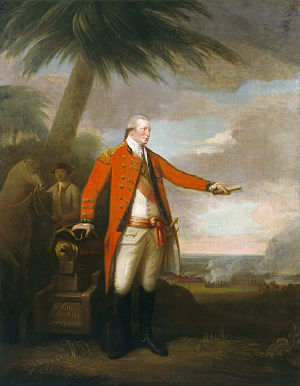| Battle of Buxar | |||||||
|---|---|---|---|---|---|---|---|
| Part of the Seven Years' War | |||||||
 A portrait of Sir Hector Munro with the battle in the background | |||||||
| |||||||
| Belligerents | |||||||
|
|
| ||||||
| Commanders and leaders | |||||||
|
|
| ||||||
| Strength | |||||||
| 17,072 | 40,112 | ||||||
| Casualties and losses | |||||||
|
289 killed 499 wounded 85 missing[2][3] |
2,000 killed 4,000 wounded[2] | ||||||
The Battle of Buxar was fought between 22 and 23 October 1764, between the forces of the British East India Company, under the command of Major Hector Munro, and the combined armies of Balwant Singh, Maharaja of the Banaras State; Mir Qasim, Nawab of Bengal; Shuja-ud-Daula, Nawab of Awadh; and Shah Alam II, Emperor of the Mughal Empire.[4]
The battle was fought at Buxar, a "strong fortified town" within the territory of Bihar, located on the banks of the Ganges river about 130 kilometres (81 mi) west of Patna; it was a challenging victory for the British East India Company. The war was brought to an end by the Treaty of Allahabad in 1765.[5] The defeated Indian rulers were forced to sign the treaty, granting the East India Company Diwani rights, which allowed them to collect revenue from the territories of Bengal, Bihar, and Orissa on behalf of the Mughal emperor.
- ^ a b Sen, Sailendra Nath (2009). History Of The Freedom Movement In India (1857–1947). New Age International. p. 2. ISBN 9788122425765.
- ^ a b John William (2004). Fortescue's History of the British Army. Vol. 2. Naval & Military Press. ISBN 978-1-84342-715-5.
- ^ Cite error: The named reference
Black160was invoked but never defined (see the help page). - ^ Parshotam Mehra (1985). A Dictionary of Modern History (1707–1947). Oxford University Press. ISBN 0-19-561552-2.
- ^ Zaman, Faridah (2015). "Colonizing the Sacred: Allahabad and the Company State, 1797–1857". The Journal of Asian Studies. 74 (2): 347–367. doi:10.1017/S0021911815000017. JSTOR 43553588.